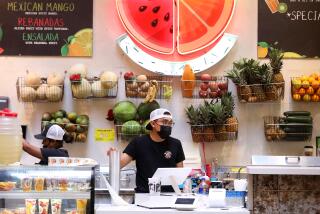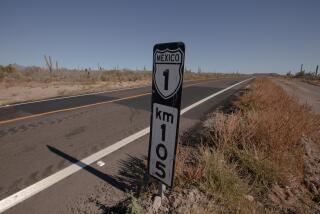New COVID rules now in effect for U.S. travelers to Baja and beyond

Baja keeps calling. But with new rules in place this week, will Californians keep answering?
Dozens of the Mexican peninsula’s resorts reopened in summer, courting Americans despite legions of U.S. experts and officials urging people to stay home because of COVID-19. Thousands came. And kept coming throughout the holidays.
Now, with infection rates far higher in both countries, U.S. officials are imposing COVID testing on international travelers and Baja’s Los Cabos area has opened a rapid-testing campaign to ease the new process.
Under a U.S. Centers for Disease Control order that took effect Tuesday, travelers entering the U.S. by air must test negative for COVID within 72 hours before departure. That means any American flying south to Mexico — age 2 and older, regardless of vaccination status — need a negative test result in that country before flying home.
U.S. officials will accept either a PCR test (also called a molecular test), which has a high accuracy rate and often yield results in 24 to 48 hours, or an antigen test, which is less accurate but often yields results in 40 minutes and costs less.
“We want to make it very easy,” said Rodrigo Esponda, managing director of the Los Cabos Tourism Board, on Friday, acknowledging that “we know that there is going to be a slowdown of the market.”
In their bid to keep U.S. visitors coming, more than 85 Los Cabos hotels, villas, timeshares and other lodgings are offering rapid tests. So are 16 testing sites at hospitals, labs, the airport and elsewhere, run by 10 companies.
The tourism board said its campaign includes “all hotels and timeshares in the destination” and that each site has medical personnel to administer the test and issue digital certificates required by the CDC.
Esponda said that though the Los Cabos airport will have testing capabilities, those are intended as a last resort. The goal, he said, “is to get people tested before reaching the airport.”
The cost is typically $60 or less per rapid test; some hotels include a rapid test as part of the price for a multiple-night stay. The PCR COVID test, Esponda said, typically costs about $200.
COVID remains a crisis on the peninsula. As of Jan. 22, Baja California Sur officials had reported 956 deaths so far (including 310 in Los Cabos) and at least 1,687 active COVID cases (at least 472 in Los Cabos). A Jan. 22 New York Times analysis of Mexican states found that Baja California Sur’s new-case rate was 28 per 100,000 people over seven days, the second-worst in the nation. In total cases, the same analysis showed Baja California Sur’s infection rate per capita is about one-third of the rate in Los Angeles County.
Since the onset of the pandemic in March, Mexico has reported more than 146,000 COVID deaths (surpassed only by the U.S., Brazil and India), and its death and new-case tallies have set records in recent weeks.
Under Mexican state COVID restrictions, lodging in Los Cabos and the rest of Baja California Sur is limited to 50% of capacity. By state requirement, residents and visitors must wear face coverings when interacting beyond their households, except when eating, drinking swimming or engaging in similar activities.
The new U.S. test requirement is a milder version of a measure Canada imposed on Jan. 7. Since that date, Canadian travelers returning from any foreign country are required to show fresh negative COVID PCR test results. After returning to Canada, those visitors also face a 14-day mandatory quarantine.
Those measures, Esponda said, have slowed Canadian arrivals from about 5,000 in December to “just a few hundred” in the first half of January.
If a homebound passenger tests positive, Los Cabos officials said, that passenger must undergo a 14-day quarantine in Los Cabos “until proof of a negative test result.” In those cases, the tourism board’s website says, hotels and resorts “will offer special accommodations and discounted rates.”
Esponda said local leaders are expecting “a reduction of 20% in arrivals” for a few weeks, followed by a tourist resurgence.
The campaign’s success or failure will have major economic consequences for Los Cabos, about 1,000 miles south of Los Angeles: It is the busiest tourist destination on the Baja peninsula, a zone of beaches, nightlife and sportfishing that has no substantial industry beyond tourism.
The region drew about 1.9 million international visitors in 2019, Esponda said. About one-third were from California.
In the U.S, authorities at local, state and national levels continue to scorn travel to Mexico. The Los Angeles County Public Health Department requires travelers to quarantine for 10 days upon return to L.A. County. California state officials forbid overnight vacations and urge Californians to stay within 120 miles of home. The CDC says “travelers should avoid all travel to Mexico,” but hasn’t made it an order.
U.S. and Mexican officials have never forbidden leisure flights from the U.S. to Mexico. Since Los Cabos hotels began reopening in June, business has climbed steadily, recently reaching 40% occupancy. In December, local leaders counted 76,000 visitors by air from within Mexico — 98% of their pre-COVID level a year before.
“We were not expecting to get to a break-even point by the end of the year,” Esponda said.
As for international arrivals, Los Cabos airport counted about 103,000 in November and 106,000 in December, almost half the pace of the year before.
“We believe that by the end of 2021 we will be at around the same levels that we had in 2019,” Esponda said.
Esponda cautioned, however, that the new testing program “is not going to be a short-term thing,” and that he expects the test requirement will remain in effect “probably for the next year or more.”
More to Read
Sign up for The Wild
We’ll help you find the best places to hike, bike and run, as well as the perfect silent spots for meditation and yoga.
You may occasionally receive promotional content from the Los Angeles Times.







